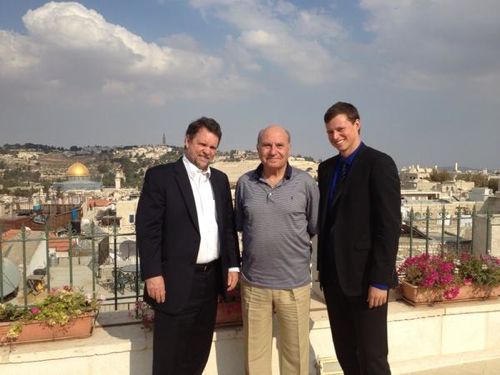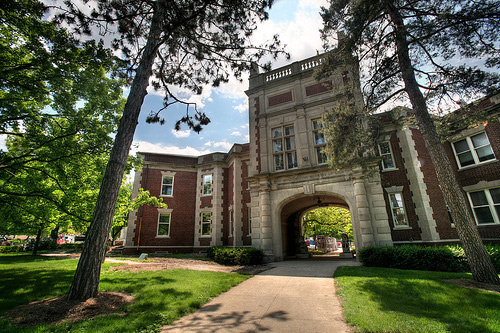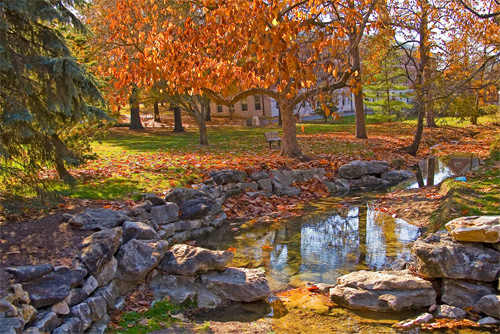THE GLOBAL PARTNERSHIP INITIATIVE: IMPROVING LIVES THROUGH INNOVATIVE DIPLOMACY
 One of the most interesting efforts I’ve encountered as Ambassador is the Global Partnership Initiative, launched by former Secretary Clinton in 2009 as part of the Department’s commitment to deploying new tools and approaches of 21st Century Statecraft.
One of the most interesting efforts I’ve encountered as Ambassador is the Global Partnership Initiative, launched by former Secretary Clinton in 2009 as part of the Department’s commitment to deploying new tools and approaches of 21st Century Statecraft.
The Global Partnership Initiative (GPI) promotes the creation of strategic collaborations among business enterprises, civil society NGOs, and public institutions to solve problems, maximize the impact of development aid, and stimulate innovation in diplomatic engagement through collective action. It creates a platform to include new participants in development and diplomacy activity in highly impactful ways.
Serving as convener, catalyst, and collaborator, the GPI has thus far worked with more than 1,000 partners and bundled approximately US$ 650 million from private and public sources to tackle chronic problems and address challenges that often get overlooked in traditional diplomatic practice. To give you a flavor of the nature of the effort, I summarize below the GPI’s four flagship initiatives and several of its other projects.
Global Alliance for Clean Cookstoves
Nearly half of the people in the world rely on open fires and stoves that emit toxic gases to cook their meals each day, resulting in (by some estimates) up to four million deaths annually. Launched in 2010, the Global Alliance for Clean Cookstoves seeks to address this preventable health risk by creating a cost-effective, clean cookstove market. The Alliance’s interim goal is to help 100 million homes adopt clean cooking solutions by 2020.

Martha Stewart features the Global Alliance’s work and a couple of new clean cookstove models on her TV show.
In 2012, the Alliance reached several key milestones including doubling its size to more than 500 partners in 38 countries; publishing a groundbreaking strategy for universal adoption of clean cookstoves and fuels; establishing the first-ever set of international cookstove standards; commissioning several cookstove research and testing centers; and catalyzing more than US$ 150 million in investments for clean cooking research.
That’s an extraordinarily powerful set of steps forward on a serious problem that you probably didn’t know existed. To learn more about the Global Alliance for Clean Cookstoves, including how you can become involved, check out cleancookstoves.org.
Partners For A New Beginning
Launched in April 2010 and chaired by former Secretary of State Madeleine K. Albright, Partners for a New Beginning (PNB) provides a coordinating platform to address youth unemployment rates in the Middle East and North Africa, which are the highest in the world. The program seeks to create partnerships that will produce 20,000 new jobs initially, job training for 40,000 young people, and an ongoing focus on sustainable job creation.

Special Representative for Global Partnerships Chris Balderston in Jerusalem with PNB Palestine Chair Zahi Khouri and colleague Joshua Walker.
To date, PNB chapters have been launched in Algeria, Egypt, Indonesia, Morocco, Pakistan, Tunisia, Turkey, Jordan, Mauritania, and the Palestinian Territories. Each local chapter identifies country-specific priorities, develops projects that address employment gaps, and works with local and American partners on implementation. PNB and its partners — including Cisco, Coca-Cola, the Rockefeller Brothers Fund, the International Youth Foundation, Mastercard Foundation, Souktel, and IBM — have launched more than 120 new projects since September 2010. The Aspen Institute serves as the PNB Secretariat. To learn more about the program and how you might be able to get involved, click here.
International Diaspora Engagement Alliance
“Diaspora,” the Greek word meaning “to scatter,” is used in English to refer to a community of people who live outside their shared country of origin or ancestry but maintain some sort of link to it. In many respects diaspora is a very American concept because the U.S. is home to more immigrants (including my grandparents) than any other nation, and those immigrants send billions of dollars in remittances each year to their families overseas (as my grandparents did). This America-based, global diaspora community holds great potential to connect the U.S. and the rest of the world in a transformative fashion, as well as to influence the direction of development and diplomacy.
Launched at an inaugural Global Diaspora Forum in May 2011, our International Diaspora Engagement Alliance (IdEA) is structured as a non-partisan, non-profit organization managed via a public-private partnership between the U.S. Department of State, the U.S. Agency for International Development, and the Migration Policy Institute. More than 1,500 diaspora communities groups, businesses, and public institutions have already convened on IdEA collaborations including investment, capacity-building, enterprise mentoring, and volunteer projects overseas driven by diaspora communities in the U.S.
IdEA has also sponsored four competitions to spur entrepreneurship and business development in target regions. The Caribbean IdEA Marketplace, African Diaspora Marketplace, and Latin American Idea Partnership (La Idea) have all effectively leveraged the strength and expertise of diaspora communities to stimulate economic activity. I was pleased to join Secretary Clinton in the Cook Islands during the Pacific Islands Forum in July 2012 to launch the fourth competition – the Pacific Islands Diaspora Marketplace.
Our intention is to continue to catalyze innovation, engagement, and impactful giving by diaspora communities through an annual Global Diaspora Forum. The 3rd Forum is scheduled for May 14-15, 2013 and will expand to multiple cities instead of just Washington, DC. This year’s focus will include developing a diaspora volunteer corps and creating a more structured platform for diaspora philanthropy.
Accelerating Market-Driven Partnerships
The fourth and newest anchor program of the GPI is called Accelerating Market-Driven Partnerships, or AMP. Announced last April during the Secretary’s Global Impact Economy Forum, AMP is intended to bring together a coalition of government, business, and non-profit entities to develop, seed, and scale innovations that generate revenue opportunities while also strengthening communities and protecting the environment.

Matthew Bishop (New York Bureau Chief for The Economist) talks with Sir Richard Branson during a prior Secretary’s Global Impact Economy Forum.
The first AMP pilot project is in Brazil, where recent economic growth lifted more than 30 million Brazilians out of poverty but created significant environmental and social challenges. AMP is working to facilitate strategic relationships between the government and potential corporate partners to address those challenges through development of new business models that will attract private enterprise. For example, AMP is working to bring to market new solutions in waste recycling, e-waste, and bio-degradable packaging — a multi-billion dollar potential market opportunity that creates jobs, relieves pressure on the government, and benefits the environment.
Other Projects
In addition to the four large flagship programs described above, the Global Partnership Initiative is working to facilitate a number of other collaborative, enterprise-based, cross-border projects. I will just mention a few of those by way of example.
Liberalizing Innovation Opportunity Nations (LIONS@FRICA). In 2012, the State Department launched the LIONS@FRICA partnership at the World Economic Forum on Africa. Linking key public and private sector partners, the effort is intended to strengthen Africa’s startup and innovation ecosystem, promote and facilitate new investments in Africa’s technology entrepreneurs, and foster innovative business models.

Five African start-up enterprises receive Lions@frica awards after pitches by dozens of entrants at the DEMO Africa conference. The winners will be flown to Silicon Valley for mentorship sessions and introductions to potential investors.
Mekong Technology Innovation Generation and Entrepreneurship Resources (TIGERS@Mekong). This month (February 2013), GPI is launching TIGERS@Mekong, a new public-private platform designed to boost competitiveness and stimulate growth in target Mekong Delta economies by training and supporting young innovators and entrepreneurs.
The Global Equality Fund. Last year GPI launched a new partnership with the mGive Foundation to promote the State Department’s Global Equality Fund by means of a mobile giving campaign. The Global Equality Fund provides support for civil society groups around the world that are working to protect the human rights of lesbian, gay, bisexual, and transgender people.
I have occasionally quarreled with diplomacy traditionalists who don’t see the foreign affairs point of any of the above activity. I think that a Metternichian focus is far too narrow and self-defeating in our modern era. Diplomacy has always been about building relationships, finding commonalities, and creating productive networks and partnerships. When practiced wisely, diplomacy uplifts, empowers, and stabilizes. It defuses potential conflict and avoids potential upheaval.
That’s what the Global Partnership Initiative is intended to do. It is impactful, strategic diplomacy at its finest, an inclusive idealism firmly rooted in pragmatic, results-oriented realism. And it saves, enriches, and enhances the lives of millions of people around the world, which elevates all of us. Sounds right to me.
![]()
 RSS
RSS






















 View my Profile
View my Profile Connect with Wellington
Connect with Wellington Watch our Videos & Subscribe
Watch our Videos & Subscribe Watch our Videos on Vimeo
Watch our Videos on Vimeo Connect on GPlus
Connect on GPlus US Embassy NZ
US Embassy NZ


 Post Entries (RSS)
Post Entries (RSS)

